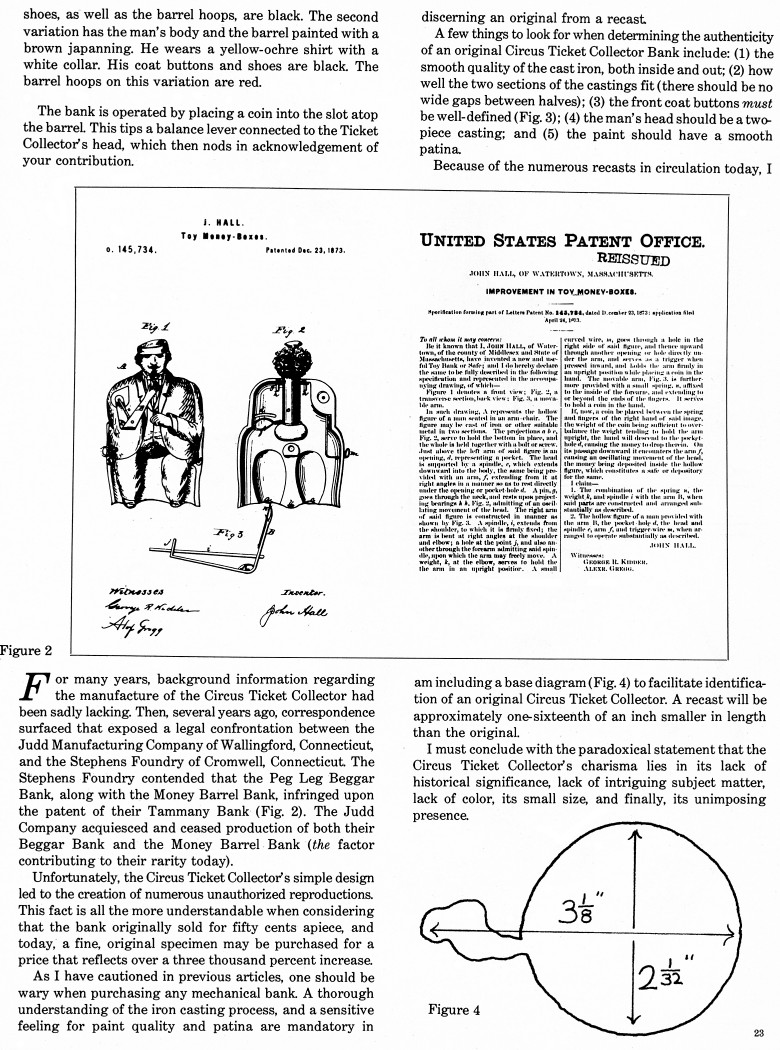|
The Circus Ticket
Collector Bank
by Sy Schreckinger – ANTIQUE TOY WORLD Magazine – July, 1983
For the first sixty years of its existence, the
Circus Ticket Collector bank was referred to as the "Money Barrel Bank."
It was advertised as such in the 1870's edition of Ehrichs Fashion
Quarterly (a New York City-based mail order firm). However, the name
"Money Barrel Bank" became obsolete; why and when this happened still
remains a mystery. The first recorded usage of the name "Circus Ticket
Collector" appeared in Ina Hayward Bellows' book, Old Mechanical Banks
published in 1940.
Both Ina Bellows, and twelve years later, in 1952, pioneer collector
John D. Meyers, in his book Mechanical Penny Banks, make reference to a
variation specifically pertaining to the face of the Circus Ticket
Collector. The variation was that the man was bearded. Other than these
references, I have never seen nor heard of a bearded variety. (If readers
of this article have seen a bank so described. I would appreciate your
advising me of it.) My contention is that quite possibly the white paint
flaking off the cheeks, chin, and upper lip of the face exposed the black
underpaint, thus giving the illusion of the beard.
The fragility of the facial paint was due to the fact that, instead
of a primer, a hard glossy black paint was used as an undercoat, causing
an adhesion problem with the white paint that was applied over it This
problem resulted in extensive flaking of the face (Fig. 1). There are
other mechanical banks which share in the same faulty use of glossy black
underpaint. They are: "Hold the Fort," (Eight Sided Building), and "John
Bull's Moneybox," (of English manufacture). These banks, including the
Circus Ticket Collector, are extremely difficult to locate in fine paint
condition, and, if found, do command a premium price.
The Circus Ticket Collector was produced in two color variations that
applied only to the body of the man and his money barrel. His face is
consistent in its color scheme, in that the hair, eyebrows, and eyes are
black; the face is an off-white, and the mouth is red (all painted over
the glossy black undercoat).
The color variations are: on one, the man's body and the barrel are
painted a copper-bronze color. He sports a white shirt with a red
V-shaped necktie. His coat buttons and shoes, as well as the barrel hoops,
are black. The second variation has the man's body and the barrel painted
with a brown japanning. He wears a yellow-ochre shirt with a white collar.
His coat buttons and shoes are black. The barrel hoops on this variation
are red.
The bank is operated by placing a coin into the slot atop the barrel.
This tips a balance lever connected to the Ticket Collector's head, which
then nods in acknowledgement of your contribution.
For many years, background information regarding the manufacture of
the Circus Ticket Collector had been sadly lacking. Then, several years
ago, correspondence surfaced that exposed a legal confrontation between
the Judd Manufacturing Company of Wallingford, Connecticut, and the
Stevens Foundry of Cromwell, Connecticut. The Stevens Foundry contended
that the Peg Leg Beggar Bank along with the Money Barrel Bank, infringed
upon the patent of their Tammany Bank (Fig. 2). The Judd Company
acquiesced and ceased production of both their Beggar Bank and the Money
Barrel Bank (the factor contributing to their rarity today).
Unfortunately, the Circus Ticket Collectors simple design led to the
creation of numerous unauthorized reproductions, This fact is all the more
understandable when considering that the bank originally sold for fifty
cents apiece, and today, a fine, original specimen may be purchased for a
price that reflects over a three thousand percent increase.
As I have cautioned in previous articles, one should be wary when
purchasing any mechanical bank. A thorough understanding of the iron
casting process, and a sensitive feeling for paint quality and patina are
mandatory in discerning an original from a recast.
A few things to look for when determining the authenticity of an
original Circus Ticket Collector Bank include: (1) the smooth quality of
the cast iron, both inside and out: (2) how well the two sections of the
castings fit (there should be no wide gaps between halves); (3) the front
coat buttons must be well-defined (Fig. 3); (4) the man's head should be a
two-piece casting; and (5) the paint should have a smooth patina.
Because of the numerous recasts in circulation today, I am including a
base diagram (Fig. 4) to facilitate identification of an original Circus
Ticket Collector. A recast will be approximately one-sixteenth of an inch
smaller in length than the original.
I must conclude with the paradoxical statement that the Circus Ticket
Collectors charisma lies in its lack of historical significance, lack of
intriguing subject matter, lack of color, its small size, and finally, its
unimposing presence. |


